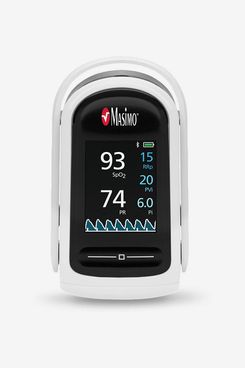
Like thermometers, toilet paper, and face masks before them, pulse oximeters — your doctor likely clipped one on your finger during your last annual physical and you haven’t thought of it since — have become the latest product propelled to sold-out status during the coronavirus outbreak. We spoke with Wayne Tsuang, a pulmonologist at the Cleveland Clinic, and Tufia Haddad, an oncologist and member of the remote patient monitoring team at the Mayo Clinic, about what a pulse oximeter does and whether or not you should keep one in your medicine cabinet.
“A pulse oximeter is a medical device that measures the oxygen content in the blood,” says Tsuang. “It’s an indicator of how much oxygen from the air we’re breathing into our lungs gets into the blood.” Clipped onto a fingertip, the device displays both oxygen saturation, as a percentage of red blood cells carrying oxygen, and your pulse rate. The normal range for oxygen saturation is 95–100 percent. Tsuang typically prescribes them for home use in patients with preexisting lung conditions or those who require supplemental oxygen. Because COVID-19 and pneumonia related to the infection can cause low oxygen, oxygen monitoring is critical in more severe cases.
While Haddad stresses that pulse oximetry cannot be used to diagnose COVID-19 (only a laboratory test can do so), it can be helpful in monitoring a patient who’s already been diagnosed. As part of the Mayo Clinic’s remote monitoring team, she prescribes pulse oximeters, along with other devices like thermometers and blood pressure cuffs, for patients to take measurements at home that are transmitted to doctors and nurses at the hospital. In one recent situation, nurses noticed a COVID-19 patient’s oxygen saturation dipping below normal and asked her to come into the hospital, where she received supplemental oxygen. “It’s always hard to know what the outcome would have been if we had not detected that drop in oxygen level even before she started having symptoms,” says Haddad, “but I’ve got to believe that was a small success.” Paul Sax, clinical director of the infectious-diseases division at Brigham and Women’s Hospital, agrees that they’re a useful tool for already-diagnosed patients. “I do advise people at risk for severe COVID to try and get one if they become sick,” he says.
As for buying your own pulse oximeter, Tsuang recommends first asking your doctor if that makes sense for you. If so, your doctor may be able to prescribe a medical-grade pulse oximeter that’s more accurate than the typical options. Haddad explains that the devices sold in drugstores and online are not labeled for medical use, and are instead meant for athletic training (like climbers at high-altitude) or relaxation and meditation practices. “The home devices are pretty good at distinguishing when the blood oxygen oxygen levels are in the normal range,” she says. “Where they lose their accuracy is when the oxygen saturation levels fall below the normal range.” So while an at-home device can confirm normal oxygen levels in healthy people, they’re less useful in helping doctors make treatment decisions for those with low oxygen.
Although it was nearly impossible to find a pulse oximeter in stock a few months ago, supplies are catching up with demand, and there are several available now if you would still like to buy one for extra assurance. Unlike the pulse oximeters found in hospitals and doctors’ offices, the over-the-counter varieties do not undergo FDA testing, so they may not be as accurate. When measuring your blood-oxygen levels at home, consider the reading in context with other symptoms — like shortness of breath and chest pain — and always reach out to your doctor if you’re concerned. As the FDA advises, keep in mind that pulse oximeters may be less accurate for people with darker skin tones or even if you’re wearing nail polish.
This model is expensive but it uses hospital-grade technology and features Bluetooth for easy tracking and storing of your measurements.
Another option that offers Bluetooth tracking and a connected app.
Last summer, New York City’s Test & Trace Corps program began distributing Take Care kits to people who have been diagnosed with COVID or potentially exposed. Each kit contains hand sanitizer, medical-grade face masks, and a thermometer for those who may have been exposed to protect others in their household and monitor their temperature. The box for those who test positive also contains a pulse oximeter. Based on this photo from the Test & Trace Corps website, it looks as if the model included in the kit is the Contec CMS50D, which you can buy for yourself for around $20.
And two smartwatches with pulse oximetry
Some fitness trackers, like the Garmin Vivoactive 4S (which this writer loves for tracking runs), feature pulse oximetry. But, as Garmin states, the Pulse Ox feature is “not intended to be used for medical purposes, nor is it intended to diagnose, treat, cure or prevent any disease or condition.” It is not FDA-cleared, either. But it still might make you feel better.
The latest iteration of the Apple Watch also has a pulse-oximetry feature. Like the Garmin, it’s not meant to be used as a medical device, but if you’re buying an Apple Watch anyway, the function is worth trying out.
The Strategist is designed to surface the most useful, expert recommendations for things to buy across the vast e-commerce landscape. Some of our latest conquests include the best acne treatments, rolling luggage, pillows for side sleepers, natural anxiety remedies, and bath towels. We update links when possible, but note that deals can expire and all prices are subject to change.










